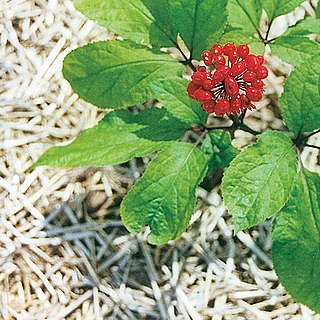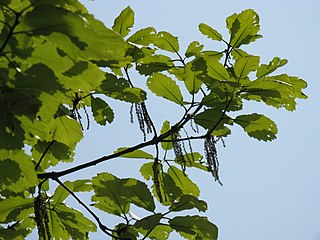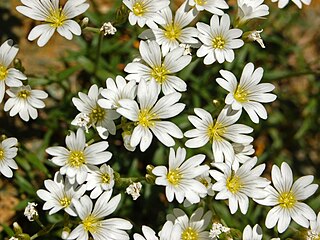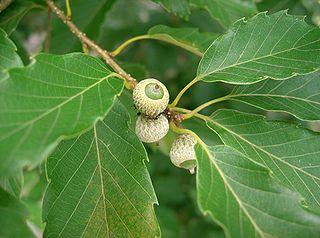
Rubus spectabilis, the salmonberry, is a species of bramble in the rose family Rosaceae, native to the west coast of North America from west-central Alaska to California, inland as far as Idaho. Like many other species in the genus Rubus, the salmonberry plant bears edible fruit, typically yellow-orange or red in color, resembling raspberries in appearance.

Eleutherococcus senticosus is a species of small, woody shrub in the family Araliaceae native to Northeastern Asia. It may be colloquially called devil's bush, Siberian ginseng, eleuthero, ciwujia, Devil's shrub, shigoka, touch-me-not, wild pepper, or kan jang. E. senticosus has a history of use in folklore and traditional Chinese medicine. Root extracts of E. senticosus are sold as a dietary supplement or cosmetic, usually under the name Siberian ginseng.

Panax ginseng, ginseng, also known as Asian ginseng, Chinese ginseng, Japanese gingseng or Korean ginseng, is a species of plant whose root is the original source of ginseng. It is a perennial plant that grows in the mountains of East Asia.

Aristolochia rotunda, commonly known as smearwort or round-leaved birthwort, is a herbaceous perennial plant native to Southern Europe.

Campanula rapunculoides, known by the common names creeping bellflower, rampion bellflower, rover bellflower, garden bluebell, creeping bluebell, purple bell, garden harebell, and creeping campanula, is a perennial herbaceous plant of the genus Campanula, belonging to the family Campanulaceae. Native to central and southern Europe and west Asia, in some parts of North America it is an extremely invasive species.

Dillenia suffruticosa, also known as simpoh air, simpor, or CB leaf, is a species of Dillenia found in tropical South East Asia in secondary forest and swampy ground. It is a highly invasive weed in Sri Lanka.

Quercus aliena, the galcham oak or oriental white oak, is a species of oak in the family Fagaceae, in the white oak section Quercus.

Bergenia crassifolia is a species of flowering plant of the genus Bergenia in the family Saxifragaceae. Common names for the species include heart-leaved bergenia, heartleaf bergenia, leather bergenia, winter-blooming bergenia, elephant-ears, elephant's ears, Korean elephant-ear, badan, pigsqueak, Siberian tea, and Mongolian tea.
Cirsium setidens, also known as gondre and Korean thistle, is a perennial plant in the genus Cirsium in the family Asteraceae. It grows naturally in submontane and mountainous area in Korean peninsula where its young leaves are used as namul. In Korean, it is called goryeo-eongeongkwi and gondeure (곤드레).

Adenostyles alpina is herbaceous perennial plant belonging to the genus Adenostyles of the family Asteraceae.

Asphodelus macrocarpus is a herbaceous perennial plant belonging to the genus Asphodelus of the Asphodelaceae family. The Latin name macrocarpus of this species derives from the Greek μακρός and καρπειον, referred to the size of the fruits.

Cerastium utriense is a species of perennial flowering plant in the genus Cerastium, belonging to the family Caryophyllaceae. It was first described in 1988. It is endemic to Italy.
Lippia substrigosa is a plant from the family Verbenaceae that is native to Central and South America. It can grow as either a shrub or a tree up to 7 metres (23 ft) tall and can be burned to produce fuel. Its essential oil may have pharmaceutical or cosmetic uses.

Achyranthes japonica, commonly known as Oriental chaff flower or Japanese chaff flower, is a perennial member of the genus Achyranthes in the family Amaranthaceae. It can be discovered on the roadside and its main distribution is in Korea and Japan.

Betula dahurica, Dahurian birch, or Asian black birch, is a species of birch which is native to China, Japan, Korea, eastern Mongolia, and Russian Far East. It was introduced to the United Kingdom and also grows at the Arnold Arboretum in Boston. In Japan, it usually grows in Nobeyama in Nagano Prefecture in the island of Honshu where it is considered to be endangered. Small population of them can also be found on Hokkaido and Kuril Islands.

Betula fruticosa, commonly known as dwarf bog birch, is a species of dwarf birch that grows in central and eastern Europe and Siberia and Mongolia on elevation of 600–1,100 metres (2,000–3,600 ft) in forests, streambanks, and swamps.

Betula chinensis, commonly known as dwarf small-leaf birch, is a species of birch that can be found in China and Korea on the elevation of 700–3,000 metres (2,300–9,800 ft).

Quercus serrata, the jolcham oak, is an East Asian species of tree in the beech family. It is native to China, Taiwan, Japan, and Korea.

Rheum webbianum is a species of herbaceous perennial rhubarb-relative in the family Polygonaceae from the southwestern Himalayan region, known in (Indian) English as Indian rhubarb, Gilgiti rhubarb or small Himalayan rhubarb.

Salix cavaleriei is a large tree from the genus of willow (Salix) with a gray-brown, furrowed bark. The leaf blades have lengths of 4 to 11 centimetres. The natural range of the species is in China. It is planted for logging and for fastening embankments.




















